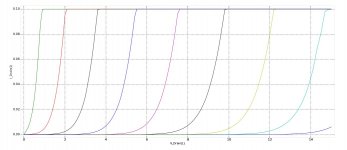I don`t use long tailed pairs, not even one pair and not even with proper application. Transistors distort like hell at high voltages.
Does that include static induction transistors? They appear to be very much like a vacuum tube triode at high voltage and low-ish current.
Transistors should be used on their own terms and merits, as a transistor not as a vacuum tube. Which SIT do you have to hand?
LU1014D, I just curved traced this transistor this afternoon. I am thinking of using it between 10V and 15V Vds in a balanced F3 configuration for direct drive of ESL/headphones. The cascode and Aleph transistors would be silicon carbide FETs.
Attachments
I am curious about the outcome.
SITs interest me very much at the moment. The first attempt will be a low voltage proof of concept.
I associate the name SIT with a Japanese principle and technique. Depletion mode devices should not generally be called a static induction transistor.
My day job is in the semiconductor industry. The SIT is a special case of a JFET. The SIT has some extra structures.
I call and SIT a device that has a large triode (concave up curves) area in its family of curves.
Every SIT that I have curve traced has some pentode shaped curves at high-ish currents. They have triode shaped curves at high-ish voltages and low-ish currents. Modern devices of this type are typically used at very high current. The manufacturers often do not trace the curves at low current and high voltage because the vast majority of users are making switching power supplies and not class-A audio amplifiers.
There are plenty of drawings and discussions of SIT device structure to be found on Google that show the difference between an SIT and an ordinary JFET.
Just my $0.02. YMMV
Electrostatic Amp THD Specs/Measurments for the Full Audio Band ? may be helpful for load, some output device options
ES headphone and cable load C is so low that poor output semi choice can mean more current going to device parasitics than the headphones
ES headphone and cable load C is so low that poor output semi choice can mean more current going to device parasitics than the headphones
Last edited:
Electrostatic Amp THD Specs/Measurments for the Full Audio Band ? may be helpful for load, some output device options
ES headphone and cable load C is so low that poor output semi choice can mean more current going to device parasitics than the headphones
This is good info. Thanks. It looks like more than 20mA bias for a class A amplifier should be adequate for a start.
- Status
- This old topic is closed. If you want to reopen this topic, contact a moderator using the "Report Post" button.
- Home
- Amplifiers
- Headphone Systems
- Looking for schematic of Stax SRM-313
